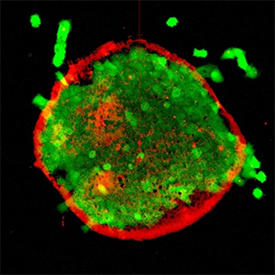

03/31/2014

© 2013 WILEY-VCH Verlag GmbH & Co. KGaA, Weinheim
Tissue engineering is expected to offer innovative regenerative approaches for cell organization and delivery in the body. A research team led by Toshinori Fujie and Ali Khademhosseini from the AIMR at Tohoku University has now developed ultrathin polymer sheets — ‘nanosheets’ — that support cell growth and transplantation at a specific location1.
Fujie says that the team’s nanosheets were inspired by the classical fairy tale “The Arabian Nights”, in which a flying carpet delivers multiple people to desirable places. To manufacture the nanosheets, the team deposited the biodegradable polymer poly(lactic-co-glycolic) acid, together with magnetic nanoparticles to aid manipulation of the nanosheets, on a microscopic stamp. The researchers then transferred the micropatterned layer onto a glass surface pre-coated with a sacrificial polymer that, when dissolved in water, releases the nanosheet from the surface.
Fujie and Khademhosseini’s team evaluated the potential for using their nanosheets to treat age-related macular degeneration — a common disease that leads to loss of sight and eventual blindness. Treatment of this disease hinges on repairing the damaged retinal pigment epithelium (RPE) layer of the eye, which is sandwiched between the retinal photoreceptors and the vascular network.
Using a syringe to transplant RPE cells at the degeneration site provides an attractive way to restore this damaged monolayer — the alternative approach is surgical intervention, which carries a high risk of infection. Materials scientists have already created several natural and artificial supports for delivery of the cells but their size exceeds that of the narrow subretinal space. Furthermore, the low flexibility of such supports hinders their aspiration and injection through a syringe.
In vitro assessments showed that RPE cells adhered to the team’s nanosheets and self-assembled into a densely packed, cobblestone-like monolayer (see image). Moreover, the magnetic particles also enhanced the surface roughness of the nanosheets, thereby promoting cell migration and proliferation — a further advantage for RPE monolayer transplantation. When compressed in a syringe needle, the RPE-bearing nanosheets retained viable cells, whereas thicker sheets preserved only a few cells of mostly low viability. The nanosheets also recovered their original shape without distortion.
When injected into the subretinal space of a swine eye ex vivo, the nanosheets properly spread and attached to the macula. The RPE monolayer also retained its cellular activity during the procedure.
The researchers are currently investigating ways to utilize their nanosheets as scaffolds for stem cells and drug molecules. “The controlled release of drugs and growth factors from the nanosheets may enhance the tissue integration of the transplanted cells,” says Fujie.
Fujie, T., Mori, Y., Ito, S., Nishizawa, M., Bae, H., Nagai, N., Onami, H., Abe, T., Khademhosseini, A. & Kaji, H. Micropatterned polymeric nanosheets for local delivery of an engineered epithelial monolayer. Advanced Materials 26, 1699-1705 (2014). | article
This research highlight has been approved by the authors of the original article and all information and data contained within has been provided by said authors.